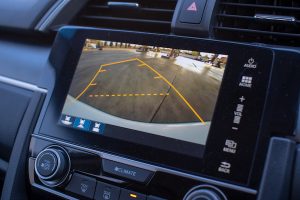As of May 2018, federal law has required that all new passenger cars, trucks, vans and other vehicles weighing less than 10,000 pounds be equipped with rearview monitoring technology. And in most cases that means rear-mounted video cameras.
Almost all backup camera systems feature on-screen guidelines: two parallel lines that help direct you into or out of parking spaces more easily. Some also feature a middle line that can help you keep the vehicle centered in the space. Modern color displays allow the system to change the color of the guidelines from green to yellow to red as you get closer to an obstruction. And that, combined with an audible warning from rear-facing sensors, can be very useful in preventing accidents related to backing up.
At first glance, the idea to any backup camera system is simple. When a vehicle is put in reverse, a camera mounted at the rear turns on and sends an image to a monitor to show what is directly behind you. However, the reality is a bit more complicated. Even at their most basic, a backup camera system is a fairly sophisticated piece of technology, and they are getting more high-tech all the time.
Where they begin to get more complex is with the image that is captured by the camera. Rather than a typical image being transmitted, a backup camera system is actually designed to send a mirror image to the monitor to ensure that the orientation is correct when the driver looks at it. If the image was a direct feed, it would be reversed. The system is designed to correct this so the view on the display makes sense.
As a leading provider of precision lenses for OEM backup camera systems, you can count on us to provide the exact lens for your design. Manufacturers demand technical and commercial improvements with each succeeding camera generation. Our product offerings will continue to grow with better performing and more cost-effective solutions. We offer a comprehensive selection of wide-angle lenses designed specifically for automotive qualified image sensors.
Generally, manufacturers install backup cameras in the vehicle’s rear trim pieces. They are fairly unobtrusive, but they can also be found hidden in the bumper, near the license plate, in the trunk lid or in the tailgate of an SUV or pickup. They are typically aimed at a downward angle to provide the best view immediately behind the vehicle. Made with wide-angle lenses, the image is more comprehensive than using just the rear-view mirror.
Technology is continually moving forward. In many ways, the future is already here. For example, many automakers offer a 360-degree camera system, often referred to as a bird’s-eye view system. That type of system uses images from four exterior cameras to create an accurate overhead picture that can be useful when maneuvering in tight places. This type of technology is usually available as an option, or as part of a technology package.
As autonomous vehicles are developed more fully, cameras will be combined with sensors and computer modules in increasingly sophisticated active systems. They’ll help cars find their way, remain oriented with lanes, maintain distance from other vehicles and objects, read road signs, avoid accidents, and adjust the car’s controls to suit the weather and traffic conditions. Many of these functions are currently available in such features as adaptive cruise control, adaptive headlights and lane keeping systems, but autonomous vehicles are expected to bring together these and many other technologies into a fully self-driving car.